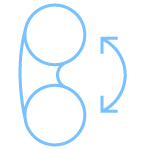
Robotic and laparoscopic surgery
More than a decade ago, a new stage in the field of surgical technology began with the incorporation of laparoscopy, facilitating access by using a small camera to areas that, for their approach, required large incisions in the past. In addition, it allowed, through a monitor, the visualization of the operative field by the entire surgical team.
In recent years we are living again a revolution in the world of surgery with the advent of robotics. The use of this technology allows the surgeon to carry out the procedure in a more precise way, with smaller incisions, less blood loss and pain as well as a faster recovery.
The main advantages offered by robotics are:
- Top vision: the image offered by the robot is sharper and three-dimensional.
- Top precision: the robot avoids natural tremor and involuntary movements.
- Greater range of movement: facilitating surgical procedures such as sutures.
- Allows accessibility to anatomically accessible spaces.
- Less postoperative pain and smaller scars.
- Less blood loss.
- Faster recovery.

Prostate cancer
Prostate cancer is pathology in which malignant cells form in the prostate gland. In Europe it is the second most diagnosed cancer and first in Spain. In most cases, the diagnosis is made through a physical examination or a PSA test. The suspicion of prostate cancer is confirmed through the anatomical-pathological analysis of the biopsy.
Robotic radical prostatectomy
It is a surgical procedure to remove the prostate using Da Vinci robotic technology. Robotic prostatectomy offers advantages over other techniques in terms of pain, blood loss and recovery time. In addition, the robotic system facilitates the maneuverability of the surgeon to obtain a greater precision compared to other surgical techniques.
Laparoscopic radical prostatectomy
It is a surgical procedure to remove the prostate using laparoscopic technology. A camera and other instruments are inserted through small incision to access to the male pelvis to perform the surgery.

Kidney and upper urinary tract cancer
Kidney cancer is among the frequent neoplasms in both men and women. The average age of diagnosis is around 60 years. The diagnosis is casual since it is usually asymptomatic (exceptionally, in the case of giving symptoms, the most frequent are the presence of blood in the urine, back pain or the appearance of a mass in the abdomen). For its diagnosis, imaging tests such as ultrasound, CT and MRI are used.
Nephrectomy / radical nephroureterectomy
Surgical procedure by which the kidney and / or the ureter is removed and the surrounding lymph nodes. This procedure can be carried out by robotic or laparoscopic approach.
Partial nephrectomy
It is the gold standar technique as long as the size and characteristics of the tumor allow it. It consists of the exeresis of the part of the kidney where the tumor is located, conserving healthy kidney tissue.
This surgery can be carried out using robotic or laparoscopic technology. The advantages of using the Da Vinci robot are based on being a minimally invasive method through small holes. Robot reproduces surgeon movements and amplifies its accuracy. Thanks to this technology, the incisions are smaller, blood loss is minimized thus allowing a faster recovery with less pain and a shorter hospital stay.

Bladder cancer
Bladder cancer is the 5th most frequent tumor in developed countries. Tobacco is the main risk factor. The signs and symptoms of this type of tumor are the appearance of haematuria (blood in the urine) and urine pain. For diagnosis, tests such as ultrasound, urinary cytology and urethrocystoscopy are used.
Robotic radical cystoprostatectomy
Minimally invasive surgical procedure to remove the bladder from the urine, prostate and surrounding lymph nodes using the Da Vinci robot. This robot reproduces the movements of the surgeon and amplifies its accuracy. Thanks to this technology, the incisions are smaller, blood loss is minimized thus allowing a faster recovery with less pain and a shorter hospital stay.
Laparoscopic radical cystoprostatectomy
Surgical procedure to remove the bladder from the urine, prostate and surrounding lymph nodes. It is done through small incisions. A camera and the rest of the instruments are inserted inside the abdomen, thus avoiding the classic abdominal incisions.

Kidney transplant from a living donor
Transplantation is the replacement of a damaged organ with a healthy one usually from a cadaveric donor, although it can also be done from a living donor. In recent years, transplantation from living donor organs has undergone a remarkable growth due to different factors, among them, the improvement of surgical technique.
Currently, the most commonly used approach is laparoscopic for organ extraction. In recent years, robotic surgery has been introduced to perform the implant.

